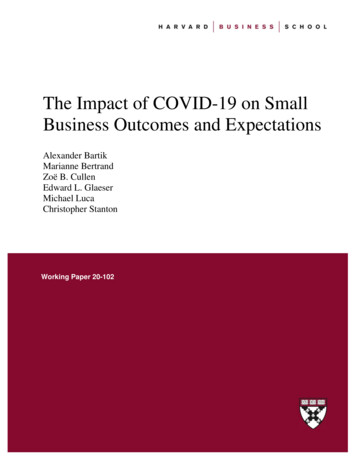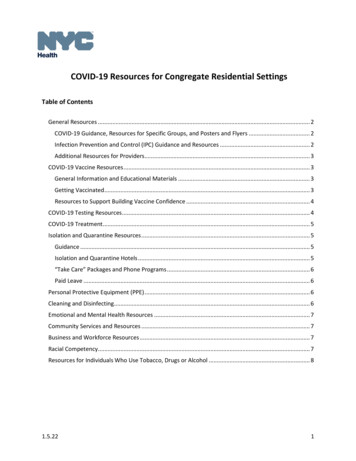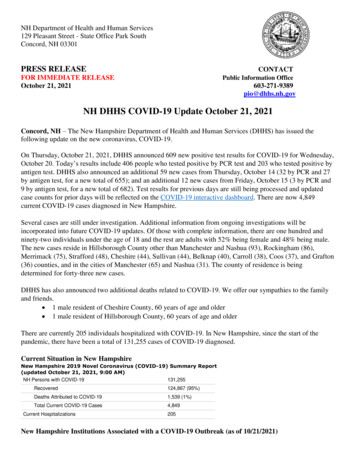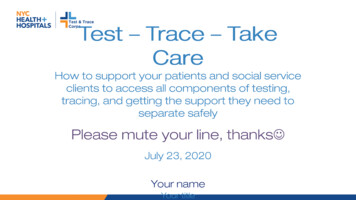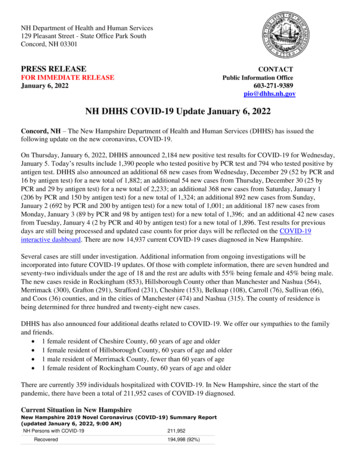
Transcription
Impact of COVID-19on the PhysicalTherapy ProfessionA Report From the American Physical Therapy AssociationAugust 2020 Update
IntroductionAPTA published its first communication about theCOVID-19 pandemic on March 3, 2020. Over the next twomonths, the country responded to a rapidly spreadingpandemic with an unprecedented shutdown that affectedschools, business, sporting events, and more.On March 17, APTA’s Board of Directors issued a statementencouraging physical therapists to “use their professionaljudgment to determine when, where, and how to providecare, with the understanding this is not the optimalenvironment for care, for anyone involved.”The day before, the Trump administration and the Centersfor Disease Control and Prevention released guidelinesthat noted that those who work in a “critical infrastructureindustry,” such as health care, have a “special responsibility”to maintain normal work schedules.Throughout the pandemic, physical therapy serviceshave been treated as essential by federal, state, andlocal guidance, although many physical therapists haveproactively stopped nonessential in-person care to flattenthe curve of the pandemic.Between April 24 and May 11, APTA surveyed arepresentative sample of 5,400 physical therapists and1,100 physical therapist assistants to gauge the impact ofthe COVID-19 pandemic on the physical therapy profession.APTA performed a follow-up survey between July 2 and 22 with 1,813 PTs and 271 PTAs responding. This reportincludes data from both surveys.The survey findings represent snapshots in time. It is expected that situations for PTs and PTAs will continue tochange according to fluctuations in COVID-19 cases and changes in state and federal guidance. 2020 American Physical Therapy Association. All rights reserved.2
Table of ContentsExecutive Summary . . . . . . . . . . . . . . . . . . . . . . . . . . . . . . . . . . . . . . . . . . . . . . . . . . . . . . . . . . . 4Practice and Workforce Implications. . . . . . . . . . . . . . . . . . . . . . . . . . . . . . . . . . . . . . . . . . . . 5Telehealth Adoption and Utility. . . . . . . . . . . . . . . . . . . . . . . . . . . . . . . . . . . . . . . . . . . . . . . . . . 9Impact on Practices. . . . . . . . . . . . . . . . . . . . . . . . . . . . . . . . . . . . . . . . . . . . . . . . . . . . . . . . . . . 12Trusted Sources of Information. . . . . . . . . . . . . . . . . . . . . . . . . . . . . . . . . . . . . . . . . . . . . . . . . 14Recommendations for the Profession . . . . . . . . . . . . . . . . . . . . . . . . . . . . . . . . . . . . . . . . . . . 15Recommendations for Policymakers . . . . . . . . . . . . . . . . . . . . . . . . . . . . . . . . . . . . . . . . . . . . 16Appendix: Timeline . . . . . . . . . . . . . . . . . . . . . . . . . . . . . . . . . . . . . . . . . . . . . . . . . . . . . . . . . . . . 17 2020 American Physical Therapy Association. All rights reserved.3
Executive SummaryThe physical therapy profession has not looked the same since the COVID-19 pandemic began to affect the UnitedStates in March. Many have seen, and continue to see, reductions in hours and income. Use of telehealth and othervideo-based consultation has increased, but in-person care remains more common and preferred. Many PTs andPTAs are facing increased financial hardships, although the pandemic is more likely to have increased career pridethan decreased it.COVID-19 Disrupts the Physical Therapy Profession Physical therapy clinics that stayed open during the early stages of the pandemic had fewer consumerswalking through their doors. Physician referrals and direct access visits declined. Care hours declined. By Julythere were signs of progress, but the effects of the pandemic remain. Employment and income suffered, particularly for PTAs. Many filed for unemployment in response. For 72% ofowners, revenue losses exceeded 50% at some point. By July, 34% of owners were seeing revenue losses of50% or more, with 40% still seeing reductions of between 26% and 50%. In July, 24% of PTs and 30% of PTAs were struggling to pay essential bills. Nonessential (flexible) spendingwas a challenge for half of PTs and 58% of PTAs, with the majority of both groups expecting it would takelonger than three months to return to previous levels of flexible spending. The pandemic didn’t change the level of career pride of most PTs and PTAs, but 29% of PTs and 31% of PTAsreported that their career pride increased as a result of COVID-19.Telehealth Adoption and Utilization Expands Prior to the pandemic, telehealth was the exception to the rule in physical therapy. Once the pandemic beganchanging behaviors, the number of PTs providing video consults significantly increased. However, by July only13% of PTs providing telehealth were treating more than 10 patients per week that way, with 32% seeing fewerthan one patient per week via telehealth on average. By late April, the ability for PTs to get paid for telehealth services was significantly improved, but challengesstill remain: Many PTs are uncertain about payment, patient satisfaction, and outcomes. And technologychallenges among patients and clinics remain a barrier to wider use.Professional Judgment Demonstrated For the 45% of PT owners who reported that their clinic closed for in-person services at some point during thepandemic, exercising professional judgment to reduce risk was the main reason.APTA Helps PTs and PTAs Stay Informed Prior to the pandemic, only 30% of practices had an emergency preparedness plan in place, leaving many PTsand PTAs looking for help. The CDC was the most-used source for external guidance, but APTA was not far behind. APTA’s website settraffic records as the association shared information on the pandemic and on shifting rules around telehealth. 2020 American Physical Therapy Association. All rights reserved.4
Practice and WorkforceImplicationsAlthough most PTs and PTAs have retained steadyemployment and pay during the pandemic, thephysical therapy community faced furloughs,layoffs, and income reductions.“We closed for in-person visits for oneweek, but then saw only truly urgentpatients, amounting to three to fourin-person visits per week. While closedwe immediately started seeing patientsvia telehealth.”Practice Hours Decline for MostPTs and PTAsStay-at-home orders reduced the volume ofphysical therapist care. While 10% of PTs sawtheir hours increase during the early phases of thepandemic, 54% experienced a decrease. An evengreater percentage of PTAs – 64% – experienceda decrease in hours. By July, 36% of PTs and 48%of PTAs were experiencing a decrease in hourscompared with before the pandemic.—PT respondentPercent of PTs Whose July Work Hours Were Lower Than Before the PandemicPercent of PTs Whose Work Hours DeclinedAcute-care hospital29%Hospital-based outpatientfacility or clinic33%Private outpatient office orgroup practice45%Skilled nursingfacility/long-term care40%46%Patient's home/home care35%School system (pre-K to 12)Academic institution(postsecondary)12%20%Inpatient rehab facility32%Other36%% across all settings0%10%20%30%40%50% 2020 American Physical Therapy Association. All rights reserved.60%70%80%90%100%5
Physician Referral and Direct Access AffectedPhysician referral and direct access both declined in the early phases of the pandemic but were showing signs ofrecovery by summer. In July, 62% of PTs were experiencing physician referral declines, compared with 88% in thespring. Meanwhile, 39% of PTs were still seeing a reduction of direct access volume in July, compared with 64%who reported declines in the spring.Percent of PTs Whose Patient Caseload DeclinedApril/MayPhysicianReferralPercent ofPTs Whose Caseload of Physician-Referred Patients Declined45%Acute-care hospitalJulyApril/May78%Percent of PTs Whose Caseload of Physician-Referred Patients DeclinedHospital-based outpatientfacility or clinicAcute-care hospitalPrivate outpatient office orgrouppracticeHospital-basedoutpatientfacility or clinicSkilled nursingfacility/long-termPrivatecareoutpatient office orPatient's home/home care62%45%78%76%97%62%63%96%74%76%group practice47%Skilled nursingfacility/long-term careSchool system (pre-K to 12)63%74%47%83%59%76%31%19%25%Inpatient rehab facilityAcademic institution(postsecondary)OtherInpatient rehab facility50%59%63%25%76%79%50%62%% across all settings0%20%30%40%50%60%88%63%80%70%79%90% 100%62%% across all settings0%10%20%30%40%50%60%19%88%70%Direct AccessPercent of PTs Whose Caseload of Direct Access Patients DeclinedAcute-care hospital97%83%31%19%Patient's home/home careAcademic institution(postsecondary)School system (pre-K to 12)Other10%July96%80%90% 100%April/MayJulyApril/May33%Percent of PTs Whose Caseload of Physician-Referred Patients DeclinedHospital-based outpatientfacility or clinicAcute-care hospital38%67%45%Private outpatient office orHospital-basedoutpatientgrouppracticefacility or clinic51%SkillednursingPrivateoutpatient office orfacility/long-term care group practice28%Skilled nursingPatient's home/home carefacility/long-term carePatient'shome/home careSchool system (pre-Kto 9%20%0%10%30%20%40%30% 2020 American Physical Therapy Association. All rights reserved.97%74%59%% across all settings% across all settings96%47%19%32%Inpatient rehab facility0%81%62%76%26% 31%Schoolsystem (pre-K to 12)Academicinstitution(postsecondary)Academic institution(postsecondary)18%Inpatient rehab facility16% 0%70%90%80%100%90% 100%6
Income DeclinesIn July, 40% of PTs and 44% of PTAs still wereexperiencing declines in weekly income compared withbefore the pandemic. And while only 5% of PTs reportedincome increases, 15% had seen an increase in hours.Meanwhile, 6% of PTAs reported income increases,while 14% had increases in hours.Hazard Pay: Approximately 7% of PTsand 6% of PTAs received hazard orpremium pay during the pandemic.Percent of July Respondents Whose Weekly Income Was Lower Than Beforethe PandemicMember TypePercent of Respondents Whose Income DeclinedPTPTA36%Acute-care hospitalMember TypePTPercent of Respondents WhoseIncome Declined32%32%38%31%Hospital-based outpatientfacility or clinicPrivate outpatient office orgroup practice47%Private outpatient office orgroup practiceSkilled nursingfacility/long-term carePatient's home/home care62%62%27%22%22%22%Inpatient rehab facility22%Inpatient rehab facility31%31%Other40%% across all settings% across all settings% across all settings% across all settings10%62%27%(postsecondary)0%39%62%46%School system (pre-K to 12)Other57%47%46%Patient's home/home careSchool system (pre-K to 12)57%38%39%Skilled nursingfacility/long-term careAcademic institution(postsecondary)Academic institutionPTA36%31%Hospital-based outpatient Acute-care hospitalfacility or clinic44%20%0%30%10%40%44%40% 30%50% 40% 60%50% 70%20%60%80%70%90%80% 100%90% 100%PTAs datareportedfromduesomedue to smallnumber of respondents.PTAs data not reportedfromnotsomesettingsto settingssmall numberof respondents.“I am worried about the long-term effects of COVID-19 on the PT industry. I washaving difficulty before finding a job. I worry it will be even harder now.”—PTA respondentPercent of RespondentsPercent Whoseof RespondentsIncome DeclinedWhoseIncomeSince the start of the pandemic, 7% of PTs have been laid off, 16% have beenDeclinedfurloughed, and 2% have resigned orEmployment Challenges Continuequit, according to the July survey. Of them, 55% returned to their previous position and 11% attained a new position,but 33% were still unemployed as of July. Of those who lost employment, 82% filed for unemployment.As for PTAs, 15% have been laid off, 26% have been furloughed, and 3% have resigned or quit, according to theJuly survey. Of them, 33% returned to their previous position and 8% attained a new position, but 54% were stillunemployed as of July. Of those who lost employment, 89% filed for unemployment. 2020 American Physical Therapy Association. All rights reserved.7
Employment Loss by Facility Based on July SurveyEmployment Loss by FacilityPTPTALaid OffFurloughedResigned/quitNone of theaboveLaid OffFurloughedResigned/quitNone of theaboveAcute-care ased outpatientfacility or clinic4%1721%811%474%2829%324%83%168%23Private outpatient office orgroup lled nursingfacility/long-term care8%76%51%184%7015%618%70%069%27Patient's home/home care6%617%163%376%7212%218%318%353%9School system (pre-K to 12)2%13%22%194%600%033%10%067%2Academic 100%7Inpatient rehab %284%8920%220%210%150%5Grand spondents could choose more than one option, so totals may exceed 100%.)% of Total0%41%Essential Care Is the NormFor PTs practicing during the pandemic, 80% said their employer never instructed them to provide in-persontreatment for what they considered nonessential physical therapist services.Personal Protective Equipment Widely ProvidedFor PTs who continued to provide in-person care during the pandemic, 85% reported being provided adequate PPE.Of those who felt the provided PPE was inadequate, 59% cited being asked to reuse PPE and 43% cited not beingprovided enough PPE, some commenting on lack of N95 masks or face shields.Personal Finances ChallengedIn July, the pandemic was affecting the ability to pay essential bills and expenses for 24% of PTs and 30% of PTAs.Nonessential (flexible) spending was a challenge for half of PTs surveyed and 58% of PTAs. Of them, 64% of PTsand 68% of PTA expected it would take longer than three months to return to previous levels of flexible spending.Career Pride IncreasesWhile most PTs and PTAs felt that the pandemic had not affected their pride in their career, 29% of PTs felt theircareer pride increased, compared with 11% who said it declined, while 31% of PTAs felt their career pride increasedcompared with 17% who felt it declined.Aerosol-Generating Procedures RareOnly 16% of PTs surveyed in July said they were engaged in aerosol-generating procedures when treating patients.The CDC recommends that providers don full PPE, including N95 or other filtering respirator masks — such aspowered air-purifying respirators or elastomeric respirator masks — when performing an aerosol-generatingprocedure with patients who have suspected or confirmed COVID-19.Patient Screenings CommonOf PTs surveyed in July, 51% were personally screening patients for COVID-19. Of those, 93% asked screeningquestions and 78% took patients’ temperatures. 2020 American Physical Therapy Association. All rights reserved.8
Telehealth Adoptionand UtilityPerhaps no specific area of health care was impacted as dramatically by the pandemic as was telehealth.On March 17, the Centers for Medicare and Medicaid Services announced it was easing restrictions in ways thatwould allow PTs to provide “e-visits.” It wasn’t until April 30 – after significant advocacy by APTA and its members –that CMS included PTs and PTAs in private practice among the providers eligible to bill for services provided throughreal-time, face-to-face technology. Then on May 27, CMS recognized outpatient facility-based providers among thosewho can bill for telehealth services provided through real-time, face-to-face technology under Medicare.The number of PTs providing telehealth rapidly increased, but most have used it minimally.PTs Pivot to VideoPrior to the pandemic, 98% of PTs surveyed were not providing live video consults. By July, 47% reported providinglive video consults. Of those, just under half (45%) treated between one and five patients per week in that manner,32% treated fewer than one patient per week, 11% treated six to 10 patients per week, and 13% treated more than10 patients via live sultby PTs32%Fewer than 1 per week45%1–511%6 – 1013%More than 100%10%20%30%40%50%60%70%80%90%100%“I have found some aspects of video visits highly helpful (e.g., seeing sittingposition where they watch TV, seeing sleeping position using their pillows, etc.),and plan to continue with videos as part of my treatments after the pandemic.”—PT respondent 2020 American Physical Therapy Association. All rights reserved.9
Uncertainty PersistsOf PTs surveyed in July, half were unsure which payers reimbursed fortelehealth services and 56% were unsure if telehealth services werereimbursed at the same rate as in-person care. Similar uncertaintyextended to satisfaction and outcomes, with 46% not knowing how theirpatients valued their telehealth care compared with in-person care and 49%unable to compare outcomes in both settings.In-Person Outperforming TelehealthOf those who could compare patient satisfaction and outcomes, 46% ofPTs said patient satisfaction was equivalent or improved via telehealth,47% reported equivalent or improved outcomes, 54% reported lower patientsatisfaction, and 53% reported poorer results.“Patients visit ourclinic to get out of thehouse and interactwith others. We donot force them intotelehealth if theywould rather do liveservices.”—PT respondent“Patients really want hands-on care.”—PT respondent 2020 American Physical Therapy Association. All rights reserved.10
Zoom Leads the Way“Many olderpatients are nottech-savvy. Mostof our patients areover 60 years old.”The most popular platform for video consults was Zoom, identified by 45% ofPTs surveyed in July. Doxy.me was used by 27%, and Epic by 10%. Respondentsidentified more than two dozen platforms used to facilitate video-based care.TelehealthBeingUtilizedTelehealth PlatformsPlatforms BeingUtilizedby PTsZoom45%Other—PT respondent34%doxy.me27%Epic10%Medbridge7%Skype forbusiness3%BetterPT1%Phzio1%Bluejay1%Elumna 0%Neorehab 0%Vsee 0%0%10%20%30%40%50%60%70%80%90%100%Technology Gaps Create Barriers to Wider UseTwo of the top three obstacles to telehealth were related to technology: 29% said their patients and clients lackedadequate technology, while 16% said their facility’s technology was a limiting factor. Another common barrier waslack of payment for services (17%).Obstacles To Providing TelehealthPTs Obstacles to Providing TelehealthOther31%My patients and clients lack adequatetechnology to access telehealth29%27%No obstaclesMy facility lacks adequate technology toprovide telehealth16%Payers don’t reimburse for telehealthservices17%9%I’m not sure where to startI lack adequate technology to providetelehealth from homeMy state practice act doesn’t allow it5%2%0%10%20%30%40% 2020 American Physical Therapy Association. All rights reserved.50%60%70%80%90% 100%11
Impact on PracticesOf the PTs surveyed in the spring, 17% were practice owners or partners. Of them, 38% reported that revenue haddecreased 76%-100% in the early phases of the pandemic, with another 34% reporting declines of 51%-75%.In July, 15% of PTs surveyed were owners, and 34% of them were still experiencing revenue declines of 51% ormore, with 40% experiencing decreases of 26% to 50%.Weekly Revenue ChangeWeeklyWeekly RevenueRevenue ChangeChangeWeekly RevenueChangeIncreased3%IncreasedIncreasedNo changeApril/MayJulyApril/May1% 3%1% 3%2%7%No changeDecreased less than 25%Decreased less than 25%Decreased 26-50%July7%2%4%7%17%17%Decreased 4%10%10%10%20%10%40%21%40%21%Decreased 26-50%Decreased 51-75%51-75%DecreasedDecreased 51-75%Decreased 76-100%Decreased 0%Professional Judgment DemonstratedNearly half (45%) of owners surveyed in July reported that their clinic closed at least temporarily due to COVID-19.Of them, 58% closed for more than four weeks. Of the practices that closed, the top reason cited was professionaljudgment (82%), followed by patient cancelations (34%), and governor’s orders and insufficient safety precautionssuch as a lack of PPE (each at 26%).“I felt as health care professionals we needed to model the behavior being requestedof all citizens. We closed for two weeks and reevaluated. We determined whichpatients really needed to be seen in the clinic and who realistically could come in,and we determined who we could see via telehealth and e-visits.” —PT respondent 2020 American Physical Therapy Association. All rights reserved.12
Reasons for Facility ClosuresReasons for Facility ClosuresProfessional judgment82%Patient cancellations or no-shows forin-person visits34%Insufficient safety precautions, such asPPE or space for physical distancing26%Mandatory orders from governor26%Lack of patients willing and/or able toaccess telehealth24%20%Insufficient financial resources6%Other3%Insufficient staffing0%10%20%30%40%50%60%70%80%90% 100%Small Business Loans PursuedIn response to revenue decline, 75% of owners surveyed in July applied for a small business loan, with 92% of themreceiving small business relief. Most owners (94%) applied for the Paycheck Protection Program. Additionally, 52%received funds from the 30 billion CARES Act general distribution fund.Emergency Preparedness Plans RarePrior to the pandemic, 30% of the responding owners/partners in the spring had an emergency preparedness planin place, which helped most with policies and procedures (46%) and communications (37%).“We, as a company, have learned that we have many deficits that need to beaddressed to better handle situations such as the COVID-19 pandemic. Workingremotely has highlighted our deficits in communication, PPE equipment, and abilityto effectively manage staff resources.” —PT respondent 2020 American Physical Therapy Association. All rights reserved.13
Trusted Sourcesof InformationIn a period of rapid change, APTA was a trusted sourceof information.The association’s website set a single-day traffic record on March17 — more than 68,000 users and 131,000 pageviews — whenAPTA’s board of directors issued a statement on patient care andpractice management that encouraged PTs to “use their professionaljudgment to determine when, where, and how to provide care.”Over the next 10 days, traffic to APTA’s website tripled as theassociation provided guidance on COVID-19 and evolving rules relatedto telehealth. In the ensuing weeks, APTA would produce dozens ofarticles, webinars, and courses, with APTA chapters and sectionsproviding additional valuable content.APTA’s call center had a 48% increase in call volume and a 39%increase in customer service requests yet reduced its averageresponse time to support members during a time of need.“APTA section webinarshave been extremelyhelpful. I am distillingthem and sharingthis informationwith members of ourdepartment to keep ourpractice in step withthe best practitioners inour profession.”—PTA respondentThe CDC was the most helpful source of information during the pandemic, cited by 81% of PTs surveyed in July,followed by state government (46%), APTA (45%), and the PT’s employer (44%). 2020 American Physical Therapy Association. All rights reserved.14
Recommendationsfor the ProfessionThe physical therapy workforce should be better leveraged to improve health across settings and patientpopulations at all times – not only in a time of crisis. PTs and PTAs on the frontlines of the COVID-19 crisisresponse have been crucial members of the health care team, providing care in hospitals, rehabilitation facilities,and nursing homes. Meanwhile, PTs and PTAs who work in local clinics and other community-based settingshave helped ensure that essential care to individuals not affected by COVID-19 is not disrupted. Maintaining andadvancing mobility, strength, activity, and endurance — core elements of physical therapy in all settings — haspositive effects on health and function at all times. Through improved accessibility, PTs and PTAs can reduceunnecessary hospitalizations and preventable bottlenecks in the health care system, while lowering the total costof health care and improving societal health.Direct access restrictions must be removed. APTA has long advocated for consumers to have direct access tophysical therapist services. Efforts to flatten the curve are specifically designed to avoid overwhelming hospitalsand other medical facilities. Enabling consumers to go straight to a PT without restrictions allows more timely andeffective care to optimize outcomes in all situations and is of heightened importance during a pandemic.All PTs and PTAs must have access to personal protective equipment and training on its proper use. The CDChas developed a document, Strategies to Optimize the Supply of PPE and Equipment, to help health care providersmanage a “sudden, unexpected increase in patient volume that would otherwise severely challenge or exceed thepresent capacity of a facility.” PPE is essential not only for the safety of therapists but for the safety of patients.PTs and PTAs should develop long-term strategies for telehealth. Telehealth has enabled PTs to treat and advisepatients who otherwise might have gone without care during the public health emergency. Moving forward, PTsmust ensure that they fully understand evolving regulations and best practices to ensure patient safety, privacy,and quality of care. Some patients — especially those who live in rural and remote areas and those with underlyinghealth conditions — will rely on physical therapy services delivered via telehealth. Patient access to physicaltherapy via telehealth must continue beyond the public health emergency. (See Recommendationsfor Policymakers) 2020 American Physical Therapy Association. All rights reserved.15
Recommendationsfor PolicymakersOn April 14, APTA sent a letter to House Speaker Nancy Pelosi and Majority Leader Mitch McConnell that featuredthe following recommendations:Provide economic stability to the health care of older adults. Now is not the time to reduce payment to providersunder the Medicare program. In the 2020 final Medicare Physician Fee Schedule rule, CMS reduced payment,effective January 1, 2021, to more than three dozen categories of health care providers in order to increasepayment for primary care health professionals. To prevent these cuts from going into effect, Congress shouldwaive the budget neutrality requirements for a period of no less than five years for purposes related to theproposed evaluation and management payment adjustments.Support health care providers and first responders on the front lines of the pandemic. Include funding for “hazardpay” to assist health care providers who are deemed essential during the COVID-19 pandemic. Also, the federalgovernment must do significantly more to facilitate the timely manufacturing and distribution of ventilators andPPE through a process that is transparent, equitable, based on need, and noncompetitive.Provide additional economic support specifically to health care providers with small businesses. Congressshould include small businesses in the Immediate Relief for Rural Facilities and Providers Act, which providestargeted financial support and grants to health care providers.Protect students with disabilities. No additional waivers for either the Individuals with Disabilities Education Act(IDEA) or the Rehabilitation Act of 1973 are warranted. Given that IDEA offers flexibility by design, and that states,districts, communities, and families are working together to find solutions to the problems they face in the nextseveral months, this is not the time to roll back civil rights protections for students with disabilities.Small business workforce flexibility. Locum tenens arrangements ensure that care is continued by anotherlicensed, qualified provider during a temporary provider absence due to illness. Inclusion of the PreventInterruptions in Physical Therapy Act (H.R. 5453) in any legislative package would relieve potential staffingshortages faced by small clinics and ensure uninterrupted care to Medicare beneficiaries.Implement a long-term policy solution on telehealth. Congress should pass legislation that would provide apermanent policy solution to expand use of telehealth services by physical therapy providers.Improve access to rehabilitation for COVID-19 patients at community health centers. Congress should include thePrimary Health Services Enhancement Act (H.R. 5693) as part of any future COVID-19 relief package. This bipartisanlegislation would expand patient access to essential physical therapy services to children and adults who receive careat rural health clinics and federally qualified health centers, also known as community health centers. 2020 American Physical Therapy Association. All rights reserved.16
Appendix: TimelineItems specifically impacting the physical therapy profession are in blue.Dec. 31, 2019: The World Health Organization’s China Country Office is informed of a cluster of pneumonia casesof unknown cause in Wuhan, Hubei Province, leading to identification of a novel coronavirus.Jan. 21, 2020: The United States has its first confirmed case, in Washington state, by a man who developedsymptoms after a trip to Wuhan.Jan. 30, 2020: The WHO declares a global health emergency.Jan. 31, 2020: The Trump administration restricts travel from China.Feb. 6, 2020: Although it will not be linked to the pandemic until April, the first known coronavirus death in Americaoccurs in Santa Clara County, California.Feb. 11, 2020: The WHO names the disease caused by the virus COVID-19, short for coronavirus disease 2019.Feb. 19, 2020: If it hasn’t done so already, the pandemic hits close to home for the physical therapy professionwhen the Life Care Center in Kirkland, Washington, has its first patient sent to the hospital for what becomes aconfirmed case of COVID-19, although a 911 call had described someone at the center as having similar symptomson January 29. B
COVID-19 Disrupts the Physical Therapy Profession Physical therapy clinics that stayed open during the early stages of the pandemic had fewer consumers walking through their doors. Physician referrals and direct access visits declined. Care hours declined. By July there were signs of progress, but the effects of the pandemic remain.

